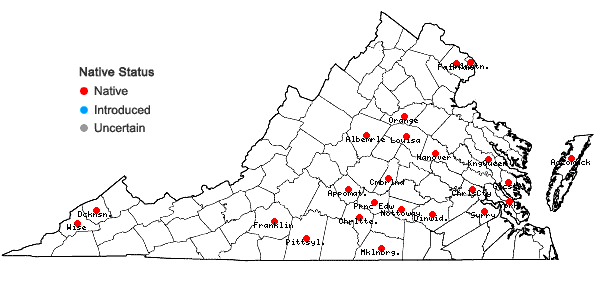Elymus glabriflorus (Vasey ex L.H. Dewey) Scribn. & C.R. Ball var. australis (Scribn. & C.R. Ball) J.J.N. Campbell
No images available.

Show image without county labels
Detail
- Family
- Poaceae
- Botanical Name
- Elymus glabriflorus (Vasey ex L.H. Dewey) Scribn. & C.R. Ball var. australis (Scribn. & C.R. Ball) J.J.N. Campbell
- Common Name
- Hairy Southeastern Wild Rye
- Synonym(s)
- Flora of Virginia Name/Status
- Elymus glabriflorus (Vasey ex L.H. Dewey) Scribn. & C.R. Ball, in part
- Comments
- Var. australis has densely hirsute spikelets and finely pubescent and scabrous leaves; the overall spike and lemma dimensions are reported to be slightly smaller than in var. glabriflorus, but the differences strongly overlap. Map based on herbarium specimens annotated by Julian Campbell plus additional recent collections; undoubtedly incomplete due to the fact that, until recently, E. glabriflorus was subsumed under E. virginicus in most Virginia floristic studies. According to the Flora of North America, "Elymus glabriflorus varies greatly in its pubescence, but without clear taxonomic relevance. Plants that combine pubescent spikelets and, usually, pubescent leaves with somewhat shorter spikes (6-12 cm versus 9-20 cm) and lemmas (6-10 mm versus 7-13 mm) are typical on relatively dry, infertile soils, especially in hilly interior regions, and are less frequent on the southeastern coastal plain. They have been named E. glabriflorus var. australis (Scribn. & C.R. Ball) J.J.N. Campb. In contrast, glabrous to scabrous plants that are often more robust usually grow on relatively moist or damp soils of bottomlands and upland depressions." It is currently unclear whether these supposed habitat differences are applicable to Virginia populations, and there is considerable evidence that the habitats of these varieties overlap to a large degree. Further study is needed.
- Habitat
- In much the same types of habitat as var. glabriflorus - wetland ecotones, forest borders and clearings, meadows, and roadsides. The two vars. of Elymus glabriflorus are totally sympatric in Virginia, but var. australis appears to be far less common than var. glabriflorus. It has been documented sparingly in all three major physiographic regions but to date, most frequently in the Piedmont.
- Native Status
- Native
To save this map, right-click (control-click for Mac users) on the map and choose "Save Image As...".